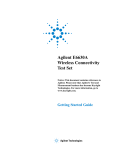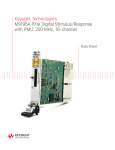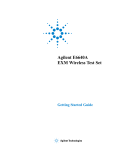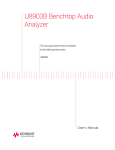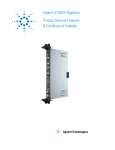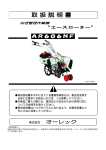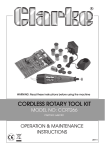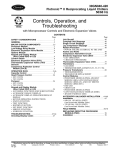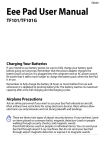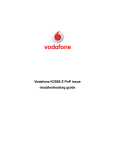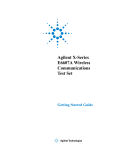Download Agilent Technologies E6640A EXM Technical data
Transcript
Agilent E6640A EXM Wireless Test Set Security Features and Document of Volatility Agilent Technologies Notices © Agilent Technologies, Inc. 2014 Manual Part Number No part of this manual may be reproduced in any form or by any means (including electronic storage and retrieval or translation into a foreign language) without prior agreement and written consent from Agilent Technologies, Inc. as governed by United States and international copyright laws. E6640-90005 Trademark Acknowledgements Microsoft® is a U.S. registered trademark of Microsoft Corporation. Windows® and MS Windows® are U.S. registered trademarks of Microsoft Corporation. Adobe Acrobat® and Reader® are U.S. registered trademarks of Adobe Systems Incorporated. Java™ is a U.S. trademark of Sun Microsystems, Inc. MATLAB® is a U.S. registered trademark of Math Works, Inc. Norton Ghost™ is a U.S. trademark of Symantec Corporation. Wikipedia® is a registered trademark of the Wikimedia Foundation. Print Date January, 2014 Printed in USA Agilent Technologies Inc. 1400 Fountaingrove Parkway Santa Rosa, CA 95403 Warranty The material contained in this document is provided “as is,” and is subject to being changed, without notice, in future editions. Further, to the maximum extent permitted by applicable law, Agilent disclaims all warranties, either express or implied, with regard to this manual and any information contained herein, including but not limited to the implied warranties of merchantability and fitness for a particular purpose. Agilent shall not be liable for errors or for incidental or consequential damages in connection with the furnishing, use, or performance of this document or of any information contained herein. Should Agilent and the user have a separate written agreement with warranty terms covering the material in this document that conflict with these terms, the warranty terms in the separate agreement shall control. Technology Licenses The hardware and/or software described in this document are furnished under a license and may be used or copied only in accordance with the terms of such license. Restricted Rights Legend If software is for use in the performance of a U.S. Government prime contract or subcontract, Software is delivered and licensed as “Commercial computer software” as defined in DFAR 252.227-7014 (June 1995), or as a “commercial item” as defined in FAR 2.101(a) or as “Restricted computer software” as defined in FAR 52.227-19 (June 1987) or any equivalent agency regulation or contract clause. Use, duplication or disclosure of Software is subject to Agilent Technologies’ standard commercial license terms, and non-DOD Departments and Agencies of the U.S. Government will receive no greater than Restricted Rights as defined in FAR 52.227-19(c)(1-2) (June 1987). U.S. Government users will receive no greater than Limited Rights as defined in FAR 52.227-14 (June 1987) or DFAR 252.227-7015 (b)(2) (November 1995), as applicable in any technical data. Safety Notices CAUTION A CAUTION notice denotes a hazard. It calls attention to an operating procedure, practice, or the like that, if not correctly performed or adhered to, could result in damage to the product or loss of important data. Do not proceed beyond a CAUTION notice until the indicated conditions are fully understood and met. WARNING A WARNING notice denotes a hazard. It calls attention to an operating procedure, practice, or the like that, if not correctly performed or adhered to, could result in personal injury or death. Do not proceed beyond a WARNING notice until the indicated conditions are fully understood and met. Warranty This Agilent technologies instrument product is warranted against defects in material and workmanship for a period of one year from the date of shipment. During the warranty period, Agilent Technologies will, at its option, either repair or replace products that prove to be defective. For warranty service or repair, this product must be returned to a service facility designated by Agilent Technologies. Buyer shall prepay shipping charges to Agilent Technologies, and Agilent Technologies shall pay shipping charges to return the product to Buyer. For products returned to Agilent Technologies from another country, Buyer shall pay all shipping charges, duties, and taxes. Where to Find the Latest Information Documentation is updated periodically. For the latest information about these products, including instrument software upgrades, application information, and product information, see the following URLs: http://www.agilent.com/find/e6640a To receive the latest updates by email, subscribe to Agilent Email Updates: http://www.agilent.com/find/emailupdates Information on preventing instrument damage can be found at: http://www.agilent.com/find/tips Is your product software up-to-date? Periodically, Agilent releases software updates to fix known defects and incorporate product enhancements. To check for software updates for your product, go to the Agilent Technical Support website at: http://www.agilent.com/find/e6640a_software 3 4 Contents 1 Table of Contents 2. Contacting Agilent Sales and Service Offices . . . . . . . . . . . . . . . . . . . . . . . . . . . . . . . . . . . . . . . . . . . . . . 7 3. Products Covered by this Document . . . . . . . . . . . . . . . . . . . . . . . . . . . . . . . . . . . . . . . . . . . . . . . . . . . . . . 9 4. Security Terms and Definitions . . . . . . . . . . . . . . . . . . . . . . . . . . . . . . . . . . . . . . . . . . . . . . . . . . . . . . . . . 11 5. Instrument Memory & Document of Volatility . . . . . . . . . . . . . . . . . . . . . . . . . . . . . . . . . . . . . . . . . . . . . 13 Memory in the Controller . . . . . . . . . . . . . . . . . . . . . . . . . . . . . . . . . . . . . . . . . . . . . . . . . . . . . . . . . . . . . . . . . . . . . 14 Memory in the Frequency Reference . . . . . . . . . . . . . . . . . . . . . . . . . . . . . . . . . . . . . . . . . . . . . . . . . . . . . . . . . . . 15 Memory in the TRX. . . . . . . . . . . . . . . . . . . . . . . . . . . . . . . . . . . . . . . . . . . . . . . . . . . . . . . . . . . . . . . . . . . . . . . . . . 16 6. Memory Clearing, Sanitization and/or Removal Procedures . . . . . . . . . . . . . . . . . . . . . . . . . . . . . . . . . 19 Instrument Sanitization Procedures . . . . . . . . . . . . . . . . . . . . . . . . . . . . . . . . . . . . . . . . . . . . . . . . . . . . . . . . . . . . 20 Removable Hard Drive Data Destruction. . . . . . . . . . . . . . . . . . . . . . . . . . . . . . . . . . . . . . . . . . . . . . . . . . . . . . .20 Hard Drive Removal . . . . . . . . . . . . . . . . . . . . . . . . . . . . . . . . . . . . . . . . . . . . . . . . . . . . . . . . . . . . . . . . . . . . . . .20 Application License Key Storage . . . . . . . . . . . . . . . . . . . . . . . . . . . . . . . . . . . . . . . . . . . . . . . . . . . . . . . . . . . . .21 Other Memories . . . . . . . . . . . . . . . . . . . . . . . . . . . . . . . . . . . . . . . . . . . . . . . . . . . . . . . . . . . . . . . . . . . . . . . . . . . . 22 7. User and Remote Interface Security Measures . . . . . . . . . . . . . . . . . . . . . . . . . . . . . . . . . . . . . . . . . . . . 23 SCPI/GPIB Control of Interfaces . . . . . . . . . . . . . . . . . . . . . . . . . . . . . . . . . . . . . . . . . . . . . . . . . . . . . . . . . . . . . . . 23 Operating System Security Features . . . . . . . . . . . . . . . . . . . . . . . . . . . . . . . . . . . . . . . . . . . . . . . . . . . . . . . . . . . . 23 Determining the Test Set’s Operating System . . . . . . . . . . . . . . . . . . . . . . . . . . . . . . . . . . . . . . . . . . . . . . . . . . . . 24 USB Interfaces . . . . . . . . . . . . . . . . . . . . . . . . . . . . . . . . . . . . . . . . . . . . . . . . . . . . . . . . . . . . . . . . . . . . . . . . . . . . . 24 Disabling or Enabling Autorun/Autoplay . . . . . . . . . . . . . . . . . . . . . . . . . . . . . . . . . . . . . . . . . . . . . . . . . . . . . .24 Windows 7 . . . . . . . . . . . . . . . . . . . . . . . . . . . . . . . . . . . . . . . . . . . . . . . . . . . . . . . . . . . . . . . . . . . . . . . . . . . .24 Windows XP . . . . . . . . . . . . . . . . . . . . . . . . . . . . . . . . . . . . . . . . . . . . . . . . . . . . . . . . . . . . . . . . . . . . . . . . . . .25 Registry Key Definitions . . . . . . . . . . . . . . . . . . . . . . . . . . . . . . . . . . . . . . . . . . . . . . . . . . . . . . . . . . . . . . . . . .25 Disable & Enable Procedure . . . . . . . . . . . . . . . . . . . . . . . . . . . . . . . . . . . . . . . . . . . . . . . . . . . . . . . . . . . . . .26 Microsoft AutoRun Patch . . . . . . . . . . . . . . . . . . . . . . . . . . . . . . . . . . . . . . . . . . . . . . . . . . . . . . . . . . . . . . . .28 More Information . . . . . . . . . . . . . . . . . . . . . . . . . . . . . . . . . . . . . . . . . . . . . . . . . . . . . . . . . . . . . . . . . . . . . . .28 Configuring USB for Read-only . . . . . . . . . . . . . . . . . . . . . . . . . . . . . . . . . . . . . . . . . . . . . . . . . . . . . . . . . . . . . .28 8. Procedure for Declassifying a Faulty Instrument . . . . . . . . . . . . . . . . . . . . . . . . . . . . . . . . . . . . . . . . . . . 31 Appendix A. References . . . . . . . . . . . . . . . . . . . . . . . . . . . . . . . . . . . . . . . . . . . . . . . . . . . . . . . . . . . . . . . . . 33 5 Contents 6 Contacting Agilent Sales and Service Offices 2 Contacting Agilent Sales and Service Offices Assistance with test and measurement needs, and information to help you find a local Agilent office, is available via the internet at, http://www.agilent.com/find/assist. If you do not have internet access, please contact your designated Agilent representative. NOTE In any correspondence or telephone conversation, refer to the instrument by its model number and full serial number. With this information, the Agilent representative can determine whether your unit is still within its warranty period. 7 Contacting Agilent Sales and Service Offices 8 Products Covered by this Document 3 Products Covered by this Document Product Name Model Numbers EXM Wireless Test Set E6640A This document describes instrument memory types and security features. It provides a statement regarding the volatility of all memory types, and specifies the steps required to declassify an instrument through memory clearing, sanitization, or removal. For additional information, go to: http://www.agilent.com/find/security IMPORTANT Be sure that all information stored by the user in the instrument that needs to be saved is properly backed up before attempting to clear any of the instrument memory. Agilent Technologies cannot be held responsible for any lost files or data resulting from the clearing of memory. Be sure to read this document entirely before proceeding with any file deletion or memory clearing. 9 Products Covered by this Document 10 Security Terms and Definitions 4 Security Terms and Definitions Term Definition Clearing As defined in Section 8-301a of DoD 5220.22-M, “National Industrial Security Program Operating Manual (NISPOM)”, clearing is the process of eradicating the data on media before reusing the media so that the data can no longer be retrieved using the standard interfaces on the instrument. Clearing is typically used when the instrument is to remain in an environment with an acceptable level of protection. Instrument Declassification A term that refers to procedures that must be undertaken before an instrument can be removed from a secure environment, such as is the case when the instrument is returned for calibration. Declassification procedures include memory sanitization or memory removal, or both. Agilent declassification procedures are designed to meet the requirements specified in DoD 5220.22-M, “National Industrial Security Program Operating Manual (NISPOM)”, Chapter 8. Sanitization As defined in Section 8-301b of DoD 5220.22-M, “National Industrial Security Program Operating Manual (NISPOM)”, sanitization is the process of removing or eradicating stored data so that the data cannot be recovered using any known technology. Instrument sanitization is typically required when an instrument is moved from a secure to a non-secure environment, such as when it is returned to the factory for calibration. Agilent memory sanitization procedures are designed for customers who need to meet the requirements specified by the US Defense Security Service (DSS). These requirements are specified in the “Clearing and Sanitization Matrix” in Appendix O of the ODAA Process Guide for C&A of Classified Systems under NISPOM. Secure Erase Secure Erase is a term that is used to refer to either the clearing or sanitization features of Agilent instruments. 11 Security Terms and Definitions 12 Instrument Memory & Document of Volatility 5 Instrument Memory & Document of Volatility This chapter summarizes all memory types in the instrument. The descriptions are divided between: 1. Memory in the Controller, 2. Memory in the Frequency Reference. 3. Memory in the TRX. 13 Instrument Memory & Document of Volatility Memory in the Controller Memory in the Controller This section contains information on the memory components used in the controller. The table provides details of the size of each memory component, its type, how it is used, its location, volatility, and the sanitization procedure. NOTE The instrument contains no user-accessible non-volatile memory, except for the SSD listed as the second item in the table below. For this reason, as indicated in the tables below, no sanitization procedure is required for any memory component except the SSD.. Table 5-1 Summary of controller instrument memory Location in Controller Sanitization Procedure Volatile (Y/N)? Purpose/Contents/Remarks User Modifiable (Y/N)? Memory Component, Type and Size Main memory (RAM) 4GB or 8GB Std. Yes No Windows Operating System memory. Data input from user, operating system. Motherboard Cycle power. This is volatile memory. Media Storage 160 GB Solid State Drive Yes Yes Windows Operating System boot device and user files including saved programs, data, settings, images, license files, etc. Data (Operating System) is factory installed; other data is user-saved. Motherboard Remove the drive; see instructions below. Flash memory for BIOS (non-volatile memory) No Yes Contains default BIOS settings for use when booting the controller. Programmed at factory or during BIOS upgrade. Settings may be toggled by user. Contains no user data. Motherboard None DDR2-533 memory No No Video RAM Motherboard Cycle power. This is volatile memory. 14 Instrument Memory & Document of Volatility Memory in the Frequency Reference Memory in the Frequency Reference This section contains information on the memory components used in the M9300A PXIe Frequency Reference. The table provides details of the size of each memory component, its type, how it is used, its location, volatility, and the sanitization procedure. Table 5-2 Location in Controller Sanitization Procedure Volatile (Y/N)? Purpose/Contents/Remarks User Modifiable (Y/N)? Memory Component, Type and Size Summary of frequency reference instrument memory 1. Flash Memory 128 Mbit No No Stores Module Model Number, Serial Number, Manufacturing Number, PCB Part and Version Numbers, Cal Verify Date, Max Module Temperature, and Calibration Data. Reference PC board None; this is not user accessible. 2. Flash Memory 128 Mbit No No Device firmware. Images can be changed using the Agilent Soft Front Panel firmware update utility. Reference PC board None; this is not user accessible. 3. Flash Memory 128 Mbit Yes No Stores Calibration Preferences: Due Date, Subject to Periodic Cal, Module Cal Warnings, Cal Due Reminder, Module Cal Reminder and Passphrase. Reference PC board All values can be reset using the Soft Front Panel. 4. FPGA Yes Yes Reference Output selections, External Reference and Frequency selections, Time Shift and Self Test results. Reference PC board Cycle power. 5. Flash Memory 128 Mbit Yes Yes Stores User Customizable Asset Number and System Identification. Reference PC board All values can be reset using IVI driver. 15 Instrument Memory & Document of Volatility Memory in the TRX Memory in the TRX This section contains information on the memory components available in your instrument. The table provides details of the size of each memory component, its type, how it is used, its location, volatility, and the sanitization procedure. 1. Config. PROM for FPGA Purpose/Contents Location in Instrument and Remarks Sanitization Procedure Volatile (Y/N)? Memory Component, Type and Size Summary of TRX instrument memory User Modifiable (Y/N)? Table 5-3 No No FPGA configuration, Board header, Module header, License storage, FLASH file system. WDIF None; this is not user accessible. Yes No Board header, Receiver calibration data (User and Factory) Downconverter User calibration data can be reset. No No FPGA configuration Downconverter None; this is not user accessible. No No Board header, RFIO board header Power Supply None; this is not user accessible. Yes No Board header, Receiver calibration data (User and Factory) Modulator User calibration data can be reset. No No FPGA configuration Modulator None; this is not user accessible. No No FPGA configuration, Board header, Module header, License storage, FLASH file system BBG None; this is not user accessible. 128Mb (16MB) 2. Flash Memory 64Mb (8MB) 3. FPGA 4Mb (512KB) 4. Flash Memory 4Mb (512KB) 5. Flash Memory 64Mb (8MB) 6. FPGA 4Mb (512KB) 7. Config. PROM for FPGA 128Mb (16MB) 16 Instrument Memory & Document of Volatility Memory in the TRX 8. DRAM Purpose/Contents Location in Instrument and Remarks Sanitization Procedure Volatile (Y/N)? Memory Component, Type and Size Summary of TRX instrument memory User Modifiable (Y/N)? Table 5-3 Yes Yes Signal data captured WDIF Cycle power. Yes Yes Signal data for playback BBG Cycle power. 4 GB DDR2 8. DRAM 4 GB DDR2 17 Instrument Memory & Document of Volatility Memory in the TRX 18 Memory Clearing, Sanitization and/or Removal Procedures 6 Memory Clearing, Sanitization and/or Removal Procedures This section explains how to clear, sanitize, and remove memory from your instrument, for all types of non-volatile memory that can be written to during normal instrument operation. 19 Memory Clearing, Sanitization and/or Removal Procedures Instrument Sanitization Procedures Instrument Sanitization Procedures Removable Hard Drive Data Destruction Several commercially available software programs exist to completely destroy all data on a data storage device such as the removable hard drive. DoD 5220.22-M is a software based data sanitization method for total data destruction. The DoD 5220.22-M sanitization method was originally defined by the U.S. National Industrial Security Program (NISP) in the National Industrial Security Program Operating Manual (NISPOM). The process involves overwriting existing information on the hard drive (or other data storage device). Typically, this means writing a 0 (zero) to every addressable location on the device, verifying the write, writing a 1 (one) to every addressable location and verifying the write, and then writing a random character (in some cases writing a 97) to every addressable location and verifying the write. Using a DoD 5220.22-M sanitization (or a variant) prevents all software and hardware based data recovery methods from obtaining information from the SSD.The instrument’s disk drive is divided at the factory into three visible partitions, labeled C:, D: and E:, plus a fourth hidden partition. Hard Drive Removal Because it is virtually impossible to completely and selectively erase all user data on a hard drive without also destroying the operating system, the best method for maintaining security when the controller must be removed from a secure area is to remove or replace the hard drive. 20 Memory Clearing, Sanitization and/or Removal Procedures Instrument Sanitization Procedures Figure 6-1 Removing the hard drive 1. Turn the PXIe chassis power off. 2. Remove the controller from the PXIe chassis. 3. Position the controller, top side up, on the workbench. Loosen the thumb screws. 4. Unseat the removable hard drive from the connector and remove it from the slot. 5. Store the hard drive in the original antistatic packaging when not in use to avoid damage. Application License Key Storage License keys for measurement applications are stored on the removable hard drive; if you need to replace the SSD, contact Agilent Customer Support for help with restoring these licenses. 21 Memory Clearing, Sanitization and/or Removal Procedures Other Memories Other Memories Other memory devices in the E6640A are described in: • “Memory in the Frequency Reference” on page 15 • “Memory in the TRX” on page 16 As these memory devices do not include user-accessible non-volatile memory, no sanitization procedure is required for any memory component except the removable hard drive. 22 User and Remote Interface Security Measures SCPI/GPIB Control of Interfaces 7 User and Remote Interface Security Measures This chapter discusses options that are available to you to control and configure remote access to the instrument, including: • SCPI/GPIB Control of Interfaces • Operating System Security Features • USB Interfaces. This topic includes information about how to set the instrument’s USB ports to read-only. IMPORTANT Users are responsible for providing security for the I/O ports for remote access, by controlling physical access to the I/O ports. The I/O ports must be controlled because they provide access to most user settings, user states, and the display memory. SCPI/GPIB Control of Interfaces The GPIB command LLO (local lockout) can be sent by the controller to disable operation of the instrument’s front-panel keys and softkey menus. However, sending the LLO command does not disable access to the instrument via its USB ports. For details of how to restrict the operation of the USB ports, see “Configuring USB for Read-only” on page 28 below. Operating System Security Features The instrument’s Windows operating system includes a variety of features that you can invoke or modify to enhance system security. These include the following: • The ability to create custom user accounts, and assign different security levels to each account by adding it to an existing group. The group types predefined by Windows are: Administrator, Power User, User, Backup Operator, and Guest, but you can also define new group types. • To provide additional protection for instruments that have a network (or internet) connection, the standard Windows Firewall is enabled by default. 23 User and Remote Interface Security Measures Determining the Test Set’s Operating System • You can install standard third-party antivirus and spyware detection software designed for use with Windows XP or Windows 7, as appropriate for your test set’s operting system. If your instrument uses a network (or internet) connection, this may be advisable. CAUTION Running any third-party program while making measurements may adversely affect the instrument’s performance. Details of all these features are provided in the "Windows Security" section of the Agilent EXM Wireless Test Set: Getting Started Guide. Determining the Test Set’s Operating System You can easily determine your instrument’s operating system version as follows: 1. Using the instrument front-panel, press System > Control Panel... 2. The Windows Control Panel appears. From the menu at the top of the Control Panel window, select Help > About Windows. 3. The About Windows message box appears, displaying the installed version of Windows. USB Interfaces The instrument’s Microsoft Windows operating system can be configured to improve the security of the USB interfaces. This section includes the following topics: • “Disabling or Enabling Autorun/Autoplay” on page 24 • “Configuring USB for Read-only” on page 28 Disabling or Enabling Autorun/Autoplay Autorun, and the associated Autoplay, are Windows features that assist users in selecting appropriate actions when new media and devices are detected. The Autorun feature is disabled in the instrument by default, for improved security, unless the Administrator account is running. (In Administrator mode, Autorun is enabled, to aid with program installation.) The procedure for disabling and enabling AutoPlay depends on your instrument’s operating system (either Windows 7 or Windows XP). To determine the operating system version of your instrument, see “Determining the Test Set’s Operating System” on page 24. Windows 7 If your instrument has the Windows 7 operating system, you can disable or enable AutoPlay via the Control Panel. Open the Control Panel and select Hardware and Sound > AutoPlay, then uncheck or check the "Use AutoPlay for all media and devices" checkbox. 24 User and Remote Interface Security Measures USB Interfaces If you want to understand details of how this AutoPlay setting affects the Windows Registry, see the “Windows XP” on page 25. Windows XP You can change the Autorun configuration by editing the value of one of two Windows Registry keys. The Windows Registry is a database that stores critical configuration information for the instrument’s operating system. CAUTION Exercise extreme caution whenever you edit the Windows Registry. Entering an incorrect Registry value, or accidentally deleting Registry keys, may have serious consequences that can prevent the system from starting, or require that you reinstall Windows. The instructions in “Disable & Enable Procedure” on page 26 below assume that you are familiar with the use of the Windows Registry Editor to modify Registry settings. Registry Key Definitions Autorun can be configured per-machine or per-user. NOTE If the per-machine Registry key is present, its settings override those of the per-user Registry key. The Registry key that controls the per-machine Autorun settings is: HKEY_LOCAL_MACHINE\Software\Microsoft\Windows\CurrentVersion\Policies\Explor er\NoDriveTypeAutoRun The Registry key that controls the per-user Autorun settings is: HKEY_CURRENT_USER\SOFTWARE\Microsoft\Windows\CurrentVersion\policies\Explore r\NoDriveTypeAutoRun In the following discussions, we use the industry-standard abbreviation HKLM for the root key HKEY_LOCAL_MACHINE, and the industry-standard abbreviation HKCU for the root key HKEY_CURRENT_USER. The DWORD value of either of these entries represents a set of single-bit flags. Each flag specifies the Autorun setting for a specific drive type, as shown in Figure 7-1. Setting a bit flag to 1 disables Autorun for that drive type. 25 User and Remote Interface Security Measures USB Interfaces Figure 7-1 Autorun Flag Definitions for NoDriveTypeAutoRun Registry entry As shown in Figure 7-1 above, the default Windows XP (post-SP2) and Windows 7 value for this entry is 0x91 (under the entry HKCU\...\NoDriveTypeAutoRun). This setting disables Autorun for Unknown and Network drives, but enables Autorun for Removable, Fixed, CD/DVD or RAM drives. You can disable Autorun for all drive types by changing the value to 0xFF, as described in the following section. Disable & Enable Procedure In view of the interaction between the per-machine and per-user Registry settings, as described above, it is recommended that, if both keys exist in your instrument’s Registry, you should alter the settings of both Registry keys to the same value at the same time. Use the following procedure to disable Autorun for all drive types, or to revert all Autorun settings to their Windows XP or Windows 7 default values. (Note that if your test set has a Windows 7 operating system, there is a simpler way to do this via the Control Panel; see “Windows 7” on page 24.) 1. Open the Windows Registry editor, using one of the following methods (depending on your test set’s operating system): a. For Windows XP, select Run... from the Windows Start menu. Then, type regedit into the Windows Run dialog box, as shown in Figure 7-2 below, and click OK. 26 User and Remote Interface Security Measures USB Interfaces Figure 7-2 Windows XP Run Dialog b. For Windows 7, click the Windows Start button at the bottom left of the screen. Type regedit into the Search programs and files box, as shown in Figure 7-3 below, then press Enter. Figure 7-3 Windows 7 Search Box 2. The Registry Editor window appears. Using the tree view control on the left of the window, navigate to the per-machine (HKLM) key: HKLM\Software\Microsoft\Windows\CurrentVersion\Policies\Explorer. 3. To disable Autorun for all drive types, set the value of entry NoDriveTypeAutoRun to 0xFF. To revert Autorun settings to the Windows default values, set the value of entry NoDriveTypeAutoRun to 0x91. 4. Again using the tree view control on the left of the Registry Editor window, navigate to the per-user (HKCU) key: HKCU\SOFTWARE\Microsoft\Windows\CurrentVersion\policies\Explorer. 5. To disable Autorun for all drive types, set the value of entry NoDriveTypeAutoRun to 0xFF. To revert Autorun settings to the Windows default values, set the value of entry NoDriveTypeAutoRun to 0x91. 6. From the Registry Editor menu, select File > Exit to save the settings and exit the editor. 7. Shut down and restart the instrument, to enable the new settings to take effect. 27 User and Remote Interface Security Measures USB Interfaces Microsoft AutoRun Patch The information in ths section applies only to Windows XP. If your test set has a Windows 7 operating system, you do not require this patch. NOTE There is a defect in Windows XP that compromises the ability to disable Autorun. This defect has been fixed by a patch from Microsoft, as described in the Microsoft Knowledge Base Article ID: 967715. This patch is included in the test set as shipped from the factory. After the patch has been applied, there will be a Registry entry at: HKLM\Software\Microsoft\Windows\CurrentVersion\Policies\Explorer\HonorAutoru nSetting with a default value of 1. More Information The following Wikipedia articles provide more information about AutoRun and AutoPlay: http://en.wikipedia.org/wiki/AutoRun http://en.wikipedia.org/wiki/AutoPlay Configuring USB for Read-only A convenient mechanism is provided to set the instrument’s USB interfaces to read-only, thus preventing transfer of files from the instrument onto USB devices. You can change this setting only when you are logged on as the Administrator. For details of how to log on to the instrument as the Administrator, see the Agilent EXM Wireless Test Set: Getting Started Guide. To change the setting, do the following: 1. If you are not currently logged on to the instrument as the Administrator, you must log off. If you are currently logged on to the instrument as the Administrator, and the Agilent XSA application is already running, go to Step 4. The log-off procedure executes more quickly if you first exit the Agilent XSA application, but you can also log off without exiting the application. 2. To log off, use one of the following procedures, depending on your instrument’s operating system: a. For Windows XP, select Log Off from the Windows XP Start menu (as highlighted in Figure 7-4 below), then click Log Off in the Log Off Windows dialog that appears. Figure 7-4 Log Off Button in XP Windows Start Menu 28 User and Remote Interface Security Measures USB Interfaces b. For Windows 7, click the Windows Start button, then select Shut down > Log off from the Windows Start menu, as shown in Figure 7-5 below. Figure 7-5 Windows 7 Log off Control 3. After you have logged on to the instrument as the Administrator, restart the Agilent XSA application. 4. When the XSA application has fully initialized (that is, when the main results view and softkey menu are visible), press the System front-panel key. 5. From the System softkey menu, select: More > Security > USB. 6. Select the option Read Only. 7. To activate the configuration change, either log out and then back in under your usual user name (which by default is "instrument"), or cycle the instrument power. 29 User and Remote Interface Security Measures USB Interfaces 30 Procedure for Declassifying a Faulty Instrument 8 Procedure for Declassifying a Faulty Instrument Even if the instrument is not able to power on, it may be declassified by removing the disk drive from the instrument, using the appropriate procedure as described in “Hard Drive Removal” on page 20. 31 Procedure for Declassifying a Faulty Instrument 32 References A: References 1. DoD 5220.22-M, “National Industrial Security Program Operating Manual (NISPOM)” United States Department of Defense. Revised February 28, 2006. May be downloaded in Acrobat (PDF) format from: http://www.dss.mil/isp/fac_clear/download_nispom.html 2. ODAA Process Guide for C&A of Classified Systems under NISPOM Defense Security Service. DSS-cleared industries may request a copy of this document via email, by following the instructions at: http://www.dss.mil/isp/odaa/request.html 3. Agilent EXM Wireless Test Set: Getting Started Guide Agilent Technologies Inc. 2013. Part Number: E6640-90001 (subject to revision). A printed copy of this document is supplied with each instrument. It is also available in Acrobat (PDF) form: • on the instrument’s disk drive at the following location: C:\Program Files\Agilent\SignalAnalysis\Infrastructure\Help\bookfiles\getstart.pdf • via download from: http://www.agilent.com/find/e6640a 4. Microsoft Knowledge Base Article ID: 967715 "How to disable the Autorun functionality in Windows": may be viewed at: http://support.microsoft.com/kb/967715 Note that a second article, at: http://support.microsoft.com/kb/953252, "How to correct ’disable Autorun registry key’ enforcement in Windows", redirects to article ID 967715. 33 References This information is subject to change without notice. © Agilent Technologies, Inc. 2014 Published in USA, January 2014 E6630-90005 Agilent Technologies


































